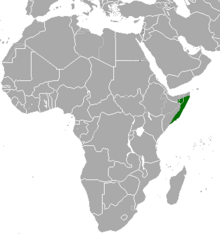Loading AI tools
Species of mammal From Wikipedia, the free encyclopedia
Speke's gazelle (Gazella spekei) is the smallest of the gazelle species. It is confined to the Horn of Africa, where it inhabits stony brush, grass steppes, and semi deserts.[2] This species has been sometimes regarded as a subspecies of the Dorcas gazelle, though this is now widely disregarded.[3] Severe habitat fragmentation means it is now impossible to assess the natural migratory or nomadic patterns of G. spekei.[4] Its numbers are under threat, and despite an increase in population, the IUCN in 2007 announced its status had changed from vulnerable to endangered. A captive population is maintained, and the wild population exists in the lower tens of thousands. As of 2008, this gazelle is classified as endangered under the IUCN Red List.
| Speke's gazelle | |
|---|---|
 | |
| At the San Diego Zoo | |
| Scientific classification | |
| Domain: | Eukaryota |
| Kingdom: | Animalia |
| Phylum: | Chordata |
| Class: | Mammalia |
| Order: | Artiodactyla |
| Family: | Bovidae |
| Subfamily: | Antilopinae |
| Tribe: | Antilopini |
| Genus: | Gazella |
| Species: | G. spekei |
| Binomial name | |
| Gazella spekei Blyth, 1863 | |
 | |
Speke's gazelle is named after John Hanning Speke, a British explorer of Central Africa. It is notable for its distinctively narrow and pointed face, and its large, inflatable nasal passages which it uses to produce a loud honking sound, especially during the breeding season as part of a display to attract mates.[5]
Seamless Wikipedia browsing. On steroids.
Every time you click a link to Wikipedia, Wiktionary or Wikiquote in your browser's search results, it will show the modern Wikiwand interface.
Wikiwand extension is a five stars, simple, with minimum permission required to keep your browsing private, safe and transparent.